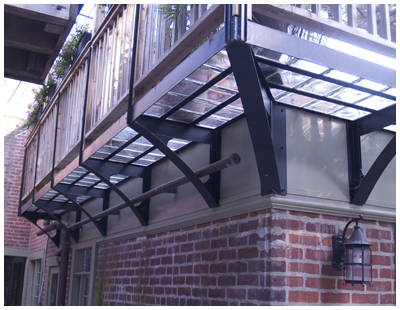The programmatic requirements of this project were multiple. The client did not want a wooden deck. She did not want a step up or down out of the house. She wanted to enhance the real estate of the “deck” without shading the kitchen below. As we were making other substantial changes to the house, we were able to work within these parameters with only a few problems.
One other change to the house involved removing the previous garage roof and slab and converting it to a kitchen. The vision was that the joists we had mostly exposed in the dining room would follow contiguously through the kitchen so the erstwhile garage walls needed to be built up sufficiently for that. The roof rafters had to be sized to carry the load of the bricks, bedding sand, snow, furniture, plants and people. The width of the rafters was specified to be identical to the old floor joists so that when distressed and stained to match the older, darker joists they were indistinguishable to the undiscerning eye. So, back to the deck, on top of the rafters we ripped dimensional lumber to create a pitch to shed water on which we put our ¾” roof sheathing. We coated this with several coats of a liquid “rubber” that gave us a seamless chemically inert membrane for the roof. We installed some drains at the low end of the roof that disgorged out through the side fascia to a 4” copper downspout. We lay a geotextile (a sort of industrial strength “scrubby” with a permeable fabric on one side) on top of all of that. This allowed for a drainage layer between the bedding sand and the roof surface. Then, the bedding sand and pavers finished it all off. All of these machinations allowed us to compress the necessary structure to the point that one could walk straight through from the second floor study out to the deck without a change in elevation.
The only way we could extend the area of the deck without creating a shadow on the kitchen windows was to use “structural” glass. The cost of actual structural glass is prohibitive, so we fabricated a steel grid to hold glass block pavers. The brackets that support the glass and steel extend through to the joists several feet and are bolted to the joists. These brackets also have welded members that support the railing system.
We added a trellis and planter for the Wisteria.
Some of the details not mentioned yet were a remote location exhaust fan for the kitchen stove and ducting, excluding water infiltration at the door and including power and water to the deck. See more photos here.

